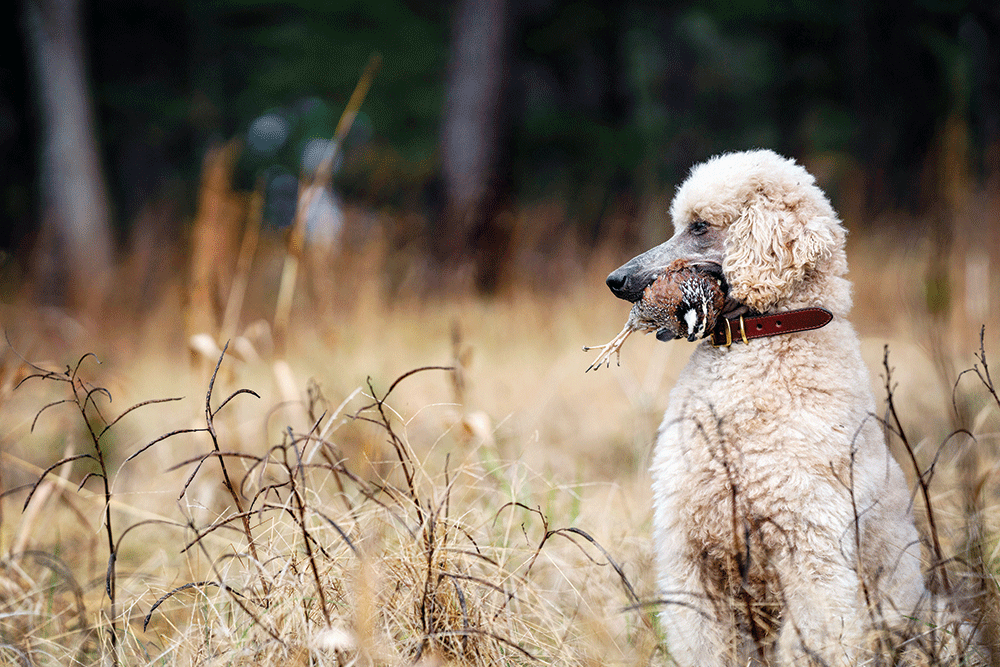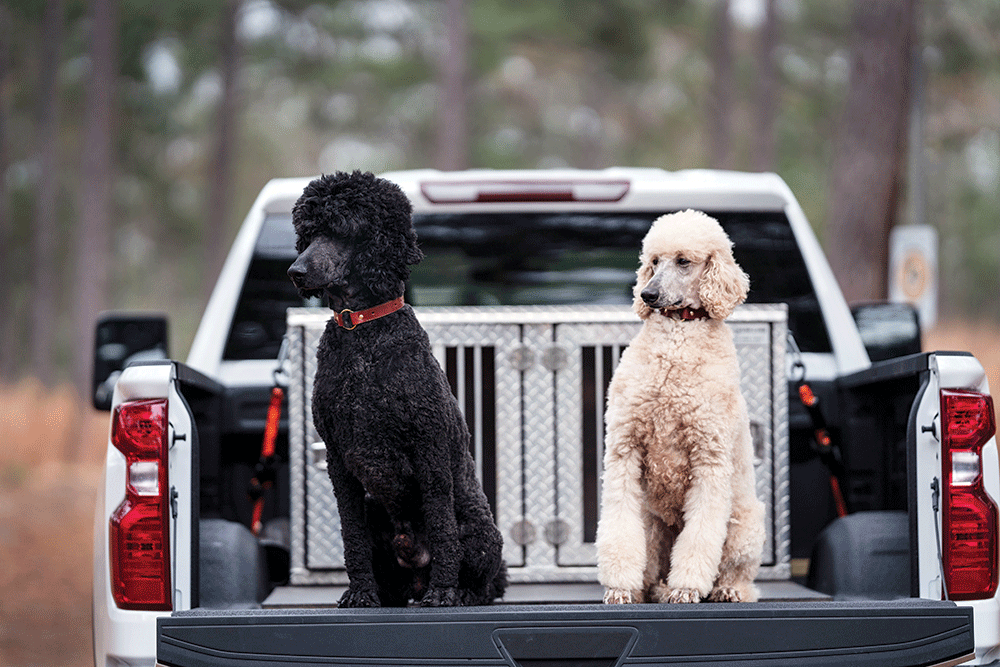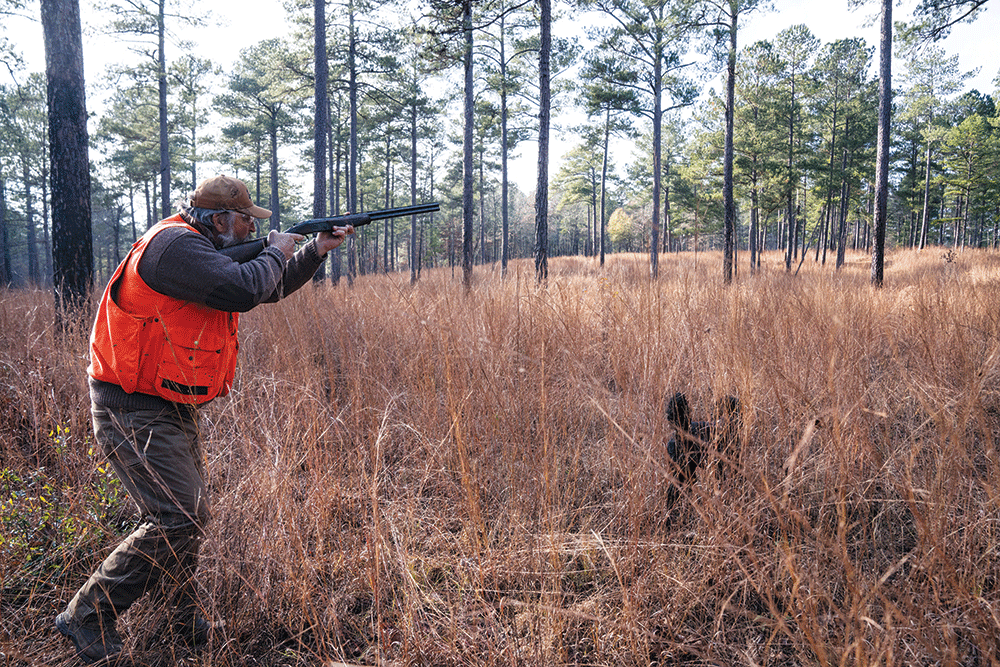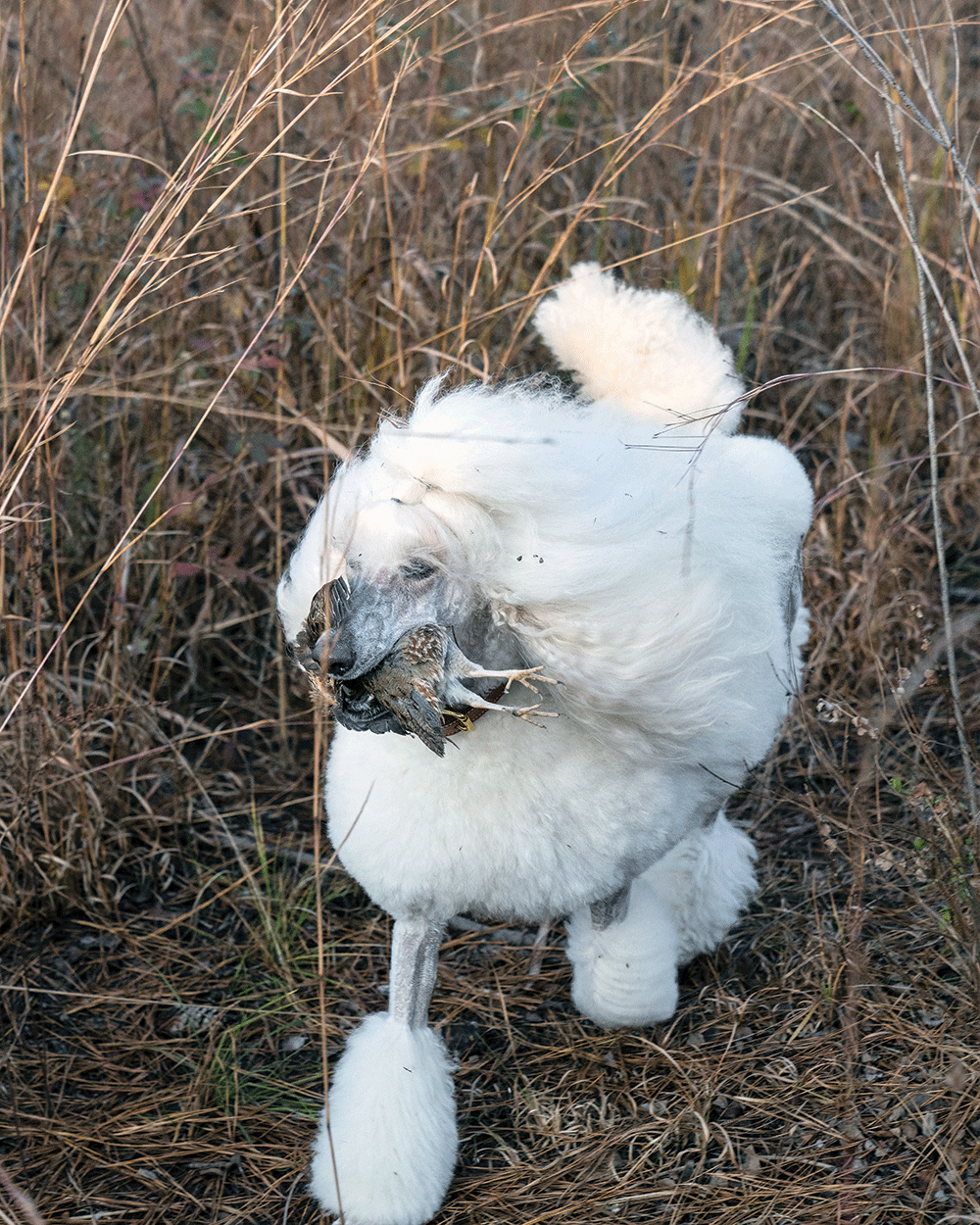Making Us Believers

A while back, my friend Will, a Southern quail and duck guide, texted me asking to help him find a poodle breeder. I snickered. Will worked mostly with pointers and English cockers but wanted something different to jazz up his hunting team. Not to offend his imagination but to set him straight, I called back and advised him to forget about it and consider a pudelpointer or Munsterlander instead. I warned him that although poodles were originally hunting dogs, the frou frou aficionados of the show ring had pretty much eradicated the breed’s hunting traits. My views on poodles were in line with the majority of comments I’d heard describing pom-pommed, pointy-nosed poodles smashing into thickets or churning through rough water as ridiculous, embarrassing, or downright preposterous. And then I met Mark McConnell…boy, was I ever wrong.
A few years ago, Mark and his standard poodle, Rain, were hunting near Athens, Georgia. He’d heard that a big migration of woodcock was passing through and knew of a spot, a perfect cover that always holds birds. They had gone directly there, relishing a dusting of fresh snow on unfrozen ground. Rain flushed several birds. Mark missed them all. Then two woodcock went up at once. Mark missed the one on the right but hit the one on the left. The right bird went up again, and when he connected, the bird dropped in the river.
“I called Rain to make a blind retrieve,” Mark remembered, “Which probably wasn’t smart. There were lots of downed trees in that stretch. But I never want to leave game behind. Rain looked at me like I was crazy, then bounded down the 10-foot bank and jumped in. She swam around a bit and finally found the bird.”
The woodcock had gotten stuck in the branches of a big overturned oak. The current was strong, and the water was cold. “She kept bobbing around in that current, and I was about to call her back when I saw her lunge. She came up with the bird but then got herself stuck on the limb.”
Starting to worry, Mark took off his boots and headed towards the water. As he was about to go in, Rain broke free. She angled towards the bank, swimming hard, then brought the bird to Mark with her signature crisp military presentation.
“It was still alive,” Mark said. “One of my proudest mo-ments with her, she trusted me and did her job, combining upland and water work in one hunt.”
Rain comes from Louter Creek Hunting Poodles in Moreland, Georgia, one of the foremost breeders of field-bred poodles in the country. Rich and Angie Louter, like Mark and most owners of hunting poodles, are used to skepticism. “I would put a poodle’s nose up against those of most traditional upland bird dogs,” Rich said. While field-bred poodles generally get media attention for their skill as waterfowl retrievers, their upland talents deserve equal press time.
“Poodles make fantastic upland bird dogs,” Rich continued. “They possess a keen nose and have the intelligence to use it properly. We have hunted pheasants and quail a lot over the years and finally have the opportunity this season to hunt grouse in Northern Wisconsin.”
Similarly, Mark has hunted Rain on pheasant, quail, and woodcock, covering seven states including Kansas and North Dakota. Mark is an assistant professor of upland bird and prairie management at Mississippi State. These days he and Rain concentrate on woodcock, acknowledging that they are the last real upland bird in his area since bobwhite quail populations have been dramatically reduced. Mark ironically points out that the old-time quail hunters didn’t like it when their dogs pointed woodcock. They didn’t want to eat the birds and felt that only the quail were worthy of pursuit.

Standard field-bred poodles are flushing dogs. As such, they need to be trained to stay in gun range. “They also have to be trained to retrieve downed birds,” Rich explained. “Poodles that are bred properly and are given a head start as young pups have a much better chance of being successful. Generally, a softer and more consistent approach will yield better results than heavy-handed, high-pressure methods. To get the point across, I spend quite a bit more time teaching rather than forcing. A willingness to think outside the box is a requirement.”
The need to train in that “outside-of-the-box” zone is familiar to most hunting poodle owners. Poodles are very smart. Agreeing with the consensus that their high intelligence makes finding the right training methods a challenge, Mark calls poodles “problem solvers.” He was a Labrador owner for years before getting Rain and sees a clear difference. “Unlike the fire-breathing Labs that will charge into anything, poodles will navigate around obstacles and be very methodical in their work,” he said.
Poodles don’t learn by repetition—the way many of us train other breeds by establishing habits and “muscle memory” through repeated drills. While training Rain, Mark learned to be ready with the next drill or lesson or alternate way of having her review a task. He gave the example of working at a pond on water retrieves: Rather than sending her from the same spot each time, he’d walk around the pond so each retrieve had a different visual approach. “It can be infuriating sometimes, because they are critical thinkers. With poodles, once they get it, if you keep repeating, they’ll get bored. And like really smart kids in school, if they get bored, they’ll get in trouble.”
Fashion-wise, it’s not easy being a poodle. The mere fact that an online search using the words “poodle cut” reaps dozens of sites offering dozens of styles suggests basic grooming in the poodle world is no simple matter. Poodle coats are regarded as hypoallergenic, although there is a long-standing controversy as to whether or not there really is such a thing or if it’s just a matter of a coat that doesn’t shed much and produces less dander to cause allergies.
The great “poodle coat color” debate is another source of style anxiety. Some sources simply list black, brown, gray, apricot, and white. Others delve into solid, parti, and phantom colors. Then there are shadings of cream, blue, silver, and brindle. The assumption can be made that those visual nuances are of more concern to show ring breeders than ones whose sights are set on intense scenting, cooperative search patterns, and strong retrieves.
The fancy pom-pom cuts associated with the show ring allegedly began a few hundred years ago when the breed was developed as water retrievers—the word “poodle” being derived from the German pudel as in the pudelhund or “water dog.” The theory is that the long thick coat would saturate and get heavy, reducing buoyancy. Thus it was shaved, leaving hair around the chest to insulate vital organs and around the joints to protect from the cold. Leaving just a top knot, the trim around the face kept hair out of the eyes.
Some breed historians note that when the breed became popular in 18th-Century France, the hairdos turned more decorative, imitating the elaborate courtiers’ style of the time. Logical as this history sounds, it is disputed by many. As Mark pointed out, “I don’t see how that hair protects the joints or organs or how reducing the hair can help swimming. I believe the clip was just a traditional styling that became the norm. Eventually people figured there had to be a purpose for it. That ‘purpose’ got repeated over and over until people believed it.”

Although Rich Louter’s dog Cooper appeared on Duck Dynasty sporting a traditional poodle cut, Rich clips his dogs’ coats fairly short all over, as do most hunters with working poodles. Likewise, Angie Louter’s snowy-white Diana, who is the top-winning champion poodle in AKC history with hunting and performance/companion titles, gets a close trim come hunting season—no drag swimming and less debris to comb out after a day in the field.
Most likely, the notion of the classic poodle cut makes disbelievers scoff at the idea of a poodle as a reliable, driven gun dog. Every owner of a field-bred standard poodle has plenty of stories of hunters smirking before they see the dogs at work. Rich’s favorite is from a South Dakota pheasant hunt with two German shorthairs in the party.
“One of the shorthairs was supposedly a ‘good’ dog, the other even ‘better.’ The first slough we hunted, the ‘good’ dog took off running, and all you saw were birds busting all over the place and one angry group of hunters.” Rich said. “The next field, that dog stayed in the truck and the ‘better’ dog took over. He managed to find a couple birds for us, but I was convinced that he passed up some birds. With a little persistence, I talked the group into hunting the field again and got out my dog Cooper—then a young but talented standard poodle. I sent him in and his tail quickly went to wagging. He dove into the brush and flushed a rooster pheasant which was then shot. He proceeded to flush several more birds in that field.”
“Needless to say, the standard poodle made a huge impression on a group of bird hunters that day. Sitting around later that evening, the conversation turned to talking about dogs, and how well Cooper did. All I said was, he’s a ‘good’ dog, but the other dog I had with me was even ‘better,’ wink wink. That dog is our now 13-year-old Reba who is the mom of Mark McConnell’s dog.”
Asked what are the current priorities in the Louter Creek breeding program, Rich replied that the health of the litters is of “utmost importance.” He added that temperament is also very high—as it should be in any quality breeding program. They also focus on proper build to handle the rigors of training and hunting, mental soundness, and the ability to cross-train for both waterfowl and upland work.
As with most breeds that become show-ring favorites, original hunting traits in many poodle lines have been undermined by an emphasis on appearance. Fortunately, serious field breeders have successfully brought back and enhanced the fundamental characteristics of the breed’s hunting origins, reinstating a strong prey drive and water ability.
In the field, Mark describes working with Rain as a “two-party hunt,” and that she seems to be just as happy bringing the bird back for him as she is for herself. “She knows not to range too far. If she does, she’ll stop and look at me. I shake my head, and she comes back 10 yards. If she sees an armadillo, she’ll stop and look at me,” Mark added. (They often see a half dozen or more armadillos on a woodcock hunt. Rain only went after them a few times when she was a pup.)
Field-bred standard poodles are wonderful companion dogs in the off season. “Look, the hunting season is short,” Rich pointed out. “So you have the rest of the year to live with the dog.” He is concerned, however, that the increasing popularity of the breed is encouraging more and more people to breed litters that are not health-tested or hunt-tested to “proof” their breeding stock.
With the right breeding and training, the proof is evident. Mark recalled being laughed at several times until the hunters saw Rain work. At a duck club in Arkansas stuffed with black Labs, Mark hid Rain from the group, but she snuck in. “Fifteen Arkansas locals were sitting around, and this elegant reddish poodle ran through the crowd. All I heard were cries of, “What is that? They just didn’t believe she’d pick up a duck. Boy, did I take some heat. The best part was after they saw her work…Pure awe.”


Originally published in Volume 9, Number 3 (April-May 2021) of Covey Rise.
























